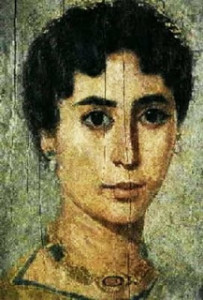The following is excerpted with kind permission from “War Against the Pagans,” in Secret History of the Witches © 2000 Max Dashu

One target of the fanatical monk was Hypatia, an astronomer, mathematician and philosopher of international reputation. Socrates Scholasticus wrote that “she far surpassed all the philosophers of her time,” and was greatly respected for her “extraordinary dignity and virtue.” [Ecclesiastical History] Hypatia’s house was an important intellectual center in a city distinguished for its learning. Damasius described how she “used to put on her philosopher’s cloak and walk through the middle of town” to give public lectures on philosophy. [Life of Isidore, in the Suda]
Admired by all Alexandria, Hypatia was one of the most politically powerful figures in the city. She was one of the few women who attended civic assemblies. Magistrates came to her for advice, including her close friend, the prefect Orestes. [Damasius, Socrates Scholasticus] In the midst of severe religious polarization, Hypatia was an influential force for tolerance and moderation. She accepted students, who came to her “from everywhere,” without regard to religion.
Hypatia was a Neoplatonist. Some have claimed that she does not really qualify as a pagan, only as a rationalist philosopher. But this description is inaccurate and misleading. First, the meaning of “philosopher” had changed considerably by late antiquity, encompassing even Christian ascetics. [MacMullen, 205 fn 24] Second, such a narrow definition of paganism fails to recognize, as its enemies did, that it constituted a much broader spectrum than temple rites and theurgy. The sacred books of the Neoplatonists were pagan—Orpheus, Homer, the Chaldean Oracles—and they embraced “the esoteric doctrines of the mysteries.” [Cumont, 202] Third, Neoplatonist philosophers were persecuted as pagans, and identified as such in the struggle over the temples. They joined and even led in the pagan defense of the Serapium in Alexandria.
One of these leaders, Antoninus, had been initiated by his mother, Sosipatra of Pergamum, a Neoplatonist philosopher and mystic seeress. Antoninus “foretold to all his followers that after his death the temple would cease to be, and even the great and holy temples of Serapis would pass into formless darkness and be transformed, and that a fabulous and unseemly gloom would hold sway over the fairest things on earth.” The Serapium was razed in 391, the year after Antoninus died. [Eunapius, 416-7] …
Hypatia’s father Theon was an astronomer and mathematician who was devoted to divination and astrology and the pagan mysteries. He wrote commentaries on the books of Orpheus and Hermes Trismegistus and poems to the planets as forces of Moira (destiny). Nothing indicates that Hypatia departed from her home culture. The Chaldean Oracles and Pythagorean numerological mysticism figured in her teachings, as the letters of Synesius indicate. Like her father, she saw astronomy as the highest science, opening up knowledge of the divine.
The surviving fragments of Hypatia’s teachings indicate a mystical orientation. Glimpses of her spiritual views survived in the letters of her disciples, which speak of “the eye buried within us,” a “divine guide.” As the soul journeys toward divinity, this “hidden spark which loves to conceal itself” grows into a flame of knowing. Hypatia’s philosophy was concerned with the “mystery of being,” contemplation of Reality, rising to elevated states of consciousness, and “union with the divine,” the One. [Dzielska, 54-5, 48-50]
Her disciples certainly regarded her in the light of a spiritual leader. Synesius of Cyrene called her “the most holy and revered philosopher,” “a blessed lady,” and “divine spirit.” Though a Christian, he refers to “her oracular utterances” and writes that she was “beloved by the gods.” [Dzielska, 47-8, 36] She spoke out against dogmatism and superstition: “To rule by fettering the mind through fear of punishment in another world, is just as base as to use force.” [Partnow, 24] Unquestionably, Hypatia’s teaching represented a challenge to church doctrine. The apparent destruction of her philosophical books underlines the point. Her mathematical works survived and were popular into the next century.
Damasius wrote that “The whole city rightly loved her and worshipped her in a remarkable way…” Her popularity galled Cyril, the new bishop of Alexandria, who “was so struck with envy that he immediately began plotting her murder…” [Damasius, op. cit.] The bishop’s enmity was also fueled by political motives: the politics of religious intolerance and domination.
When Cyril became bishop in 412, he began pushing to extend his power into the civic sphere. His enforcers were the parabalanoi, strongmen who had been the shock troops of bishop Theophilus’ war on pagans and Jews. Bishop Cyril persecuted heterodox Christian groups, closing their churches and expelling them from the city. He spread rumors of a Jewish conspiracy to murder Christians and instigated a brawl between Jews and Christians at a theater. The Jews protested that the bishop’s agents had provoked the fight. The prefect Orestes (himself a Christian) heard out their grievances and arrested one of the bishop’s allies. In 414, armed conflict broke out between Cyril’s supporters and the embattled Jews. It ended with the looting and seizure of synagogues, and the bishop expelling the ancient Jewish community from Alexandria.
Many Christians in the city sided with Orestes and put pressure on Cyril to desist. Instead, he escalated the conflict, calling in hundreds of monks from the desert. They mobbed Orestes in the streets, calling him a “sacrificer” and “Hellene”—in other words, a pagan. [Chuvin, 87-9] The monks hurled stones, wounding him in the head. The prefect’s bodyguards fled, but a crowd of bystanders jumped in to save his life.
Accusations of Witchcraft
Realizing that he was losing on public relations, the bishop changed tactics. Now he attempted to turn the people against Hypatia as a powerful woman by accusing her of harmful sorcery. A later church chronicler, John of Nikiu, explained that “she beguiled many people through satanic wiles.” It was Hypatia’s “witchcraft” that kept the prefect Orestes away from church and made him corrupt the faith of other Christians. Further, she was involved in divination and astrology, “devoted at all times to magic, astrolabes and instruments of music.” [John of Nikiu, Chronicle 84. 87-103, Online:7-20-01]
In March of 415, Peter the church lector led a mob in attacking Hypatia as she rode through the city in her chariot. Socrates Scholasticus wrote that “rash cockbrains” dragged her into the Caesarion church, stripped her naked, and tore into her body with pot-shards, cutting her to pieces. Then they hauled her dismembered body to Cinaron and burned it on a pyre. [Alic, 45-6] John Malalas accords with Socrate’s statement that the mob burned Hypatia’s remains. Hesychius’ account agrees that the mob tore Hypatia to pieces, but simply says that “her body [was] shamefully treated and parts of it scattered all over the city.” [Dzielskaielska, 93]
In John of Nikiu’s version, men came for “the pagan woman who had beguiled the people of the city and the prefect through her enchantments.” They found her sitting in a chair and dragged her through the streets until she was dead, then burned her body.[Chronicle, 84.87-103] After Hypatia’s assassination, Orestes disappeared (fled? assassinated?). Cyril prevailed, and his parabalanoi were never punished for killing Hypatia. The bishop covered up her murder, insisting that she had moved to Athens.
No one was fooled. Our nearest contemporary sources agree that the bishop was behind the witch-rumors and the killing, and that his men carried them out. Public opinion may be measured by the fact that Christian city officials continued appealing to imperial officials to curb the parabalanoi, to bring them under secular control and restrict them from public places. They were only partially successful, since the imperial court itself was in the midst of a crackdown on pagans. As for Cyril, whom John of Nikiu credits with destroying “the last remnants of idolatry in the city,” he was later declared a saint. [Dzielskaielska, 97-8, 104. 94]
Hypatia was not targeted only as a pagan. Other pagans—men—continued to be active at the university of Alexandria for decades after her death. It is clear that Hypatia’s femaleness made her a special target, vulnerable to the accusation of witchcraft. Her courage in opposing the escalating anti-Jewish violence and her moral stance against religious repression were factors as well. In defending the assault on the philosophical tradition of tolerance, Hypatia had everything to lose, yet she acted boldly.
Later in the century, her male counterparts also came under attack. By the mid-400s, pagan professors were being sentenced to death in Syria. Some time after 480, an Alexandrian Christian society called the Zealots hounded the pagan prefect and his secretary from office and into exile. The Zealots capped their triumph with the burning of “idols.” Two of them moved on to Beirut, where they incited further hunts of leading pagans. They formed a group to collect denunciations, using informers, and brought names and accusations to the bishop. This worthy held joint hearings with city officials, which led to more bonfires and the exile of pagans. [MacMullen, 26, 194 fn95]
The cultural repression used to Christianize the Roman empire was unprecedented anywhere up to that time, in extent, duration and geographic scale.
Read more about Hypatia of Alexandria:
Hypatia, Ancient Alexandria’s Great Female Scholar by Sarah Zielinski
The Real Wonder Woman: Hypatia of Alexandria by The Secret Sun
Great Philosophers: Hypatia at Oregon State University online



